Minnesota poised to join MLS in 2017, with name change

It’s looking increasingly likely that Minnesota United FC will enter MLS in 2017, and it’s looking increasingly likely that it will do so with a new name.
United was extended an MLS invitation in March 2015 and it spent the next seven months working on securing a site for a new privately-financed stadium, which will be constructed on the west side of St. Paul. It’s scheduled to be ready in 2018. But the club (soon to enter its sixth NASL season) and MLS don’t want to wait that long, according to multiple sources, necessitating a temporary venue. SI.com reported in September that the University of Minnesota’s TCF Bank Stadium and the Minnesota Twins’ Target Field were the best options and Northern Pitch claimed last week that United was leaning toward the former. A source has since confirmed that report to SI.com.
Although Twins owner Jim Pohlad is a United investor, TCF Bank Stadium probably makes more sense thanks to greater scheduling flexibility and its configuration. The Golden Gophers play on artificial turf but the new MLS stadium will have a natural grass field.
One source told SI.com that there is only a “slim” chance Minnesota waits until 2018, while another said the NASL already is planning on playing its 2017 season without United.
• Subscribe to get the best of Sports Illustrated delivered right to your inbox
While Minnesota in penciled in for next year, Atlanta United FC’s entry is inked. And that apparently has caused some consternation among those who believe it might look strange to add two Uniteds in the same season or operate a league with three. The question of dibs (assuming D.C. didn’t exhaust the permissible number of Uniteds) is a complicated one.
Atlanta was confirmed as an MLS market in April 2014, nearly a year before Minnesota. But the latter began using ‘United’ in early 2013 and arguably has a stronger claim on the name. Owner Bill McGuire, who rescued the club in late 2012, spent more than 15 years running healthcare giant UnitedHealth and hoped his reborn, rebranded team would unify fans from the Twin Cities who’d cheered for the Stars, Thunder and Kicks. Atlanta had a clean slate and seemed to pull the name out of thin air. Its connection to one of soccer’s most common monikers is more tenuous.
“The word ‘United’ has long been associated with the beautiful game around the world,” AUFC president Darren Eales said upon the unveiling. “It has particular resonance for Atlanta, as a transport hub in the Southeast, as a multi-cultural, international city and as a club committed to community.”
Whether that’s sufficient isn’t the issue. In MLS’s eyes, Atlanta United was part of the league first and as one source said, “[Owner] Arthur Blank is very good at persuading people.”
High-level discussions concerning the nickname conflict still were taking place following January’s MLS draft, leaving Minnesota little time to handle branding and apparel issues ahead of a 2017 move. And while no one could confirm that a final decision has been made, a second source with knowledge of the conversations said MLS was “inclined to say ‘no’” to Minnesota and that he didn’t expect the league to allow three Uniteds.
Multiple sources said that there was no issue with Minnesota’s popular gray and blue logo, which features a shield, loon and star, and one said that it could easily be tweaked to reflect a new name like Minnesota FC.
Critiquing the 2016 MLS uniforms
Chicago Fire

The optimism surrounding a new GM and head coach is accompanied by a welcome return to the red kit and single white hoop the Fire wore when winning trophies. Chicago was the first MLS team in mono-red and has dibs on a look that unfortunately became way too prevalent. The hoop on the new primary uniform is too thin, but otherwise it’s a crisp design that should be well received by fans, some of whom protested the red-and-blue offering worn in 2014-15. The all-white away kit featuring hints of the city flag carries over from last year.
Colorado Rapids

Colorado made just a few very subtle changes to its home uniform this year, and that’s fine. The three stripes moved from the shoulder to the side, there’s a bit of color on the cuffs and the hoops on the sock widened, which is awesome. The burgundy and white is elegant and immediately recognizable. The club's problem remains the logo, a skinny shield featuring a mountain (not rapids) similar to its NHL, NBA and MLB neighbors. It’s tough to suggest a fourth crest for a team that’s had trouble establishing an identity, but it might help. This one leaves no impact. Colorado’s sharp state flag-inspired away set carries over from 2015.
Columbus Crew SC

Once known as "America’s Hardest Working Team," Crew SC is trying too hard. For 17 years, Columbus was the only club in MLS, and one of the few in the world, to wear all-yellow. It was immediately recognizable, looked great on the field and was a genuine brand. Now it’s gone, replaced as the primary by last year’s away set. Mono-black is more closely associated with D.C. United. The new secondary is a shock to the system. Designed to reflect the yellow, white and red city flag, it’s certainly distinctive. Clubs are welcome to take chances with their away kits, but only if the overall brand holds steady.
D.C. United

A new stadium in the nation’s capital (scheduled to open in 2018) is preceded by a new club logo, United’s first since 1998. We love the wings breaking through the shield and the redesigned font, but wish the stars on the city flag–which replaces the old ball and championship star–were a bit larger. They’re lost on the black background. The new home kit maintains the club’s classic, all-black brand and the sad absence of the white chest stripes that adorned the most iconic uniform in MLS history. There must be a way to bring those back.
FC Dallas

FCD’s new home kit is the nicest in club history. The hoops that accompanied the 2005 rebrand were a good idea but always poorly executed, and Dallas gave up on them two years ago. But the common mono-red look was a failure, leading to this year’s stylish primary. The pinstripe white hoops are sleek and distinctive and aren’t overwhelmed by Adidas’s panels and seams. The uniform pops with the addition of white shorts. Hopefully FCD takes the same approach with the blue-and-white secondary kit next year.
Houston Dynamo

Houston’s new away uniform is a stunning departure from the traditional white. Black has been part of the club’s palette (check the logo). It now dominates the secondary kit save for a bright orange chevron on the chest reminiscent of the Astros’ famous “Tequila Sunrise” jerseys and the shirts Germany wore when winning the 2014 World Cup. We may not see the black too often at home (it’s hot and humid in Houston), but it should sell well. The orange fade on the primary set carries over from 2015. The Dynamo occasionally wear mono-orange, which is a mistake. The white shorts remain the way to go.
LA Galaxy
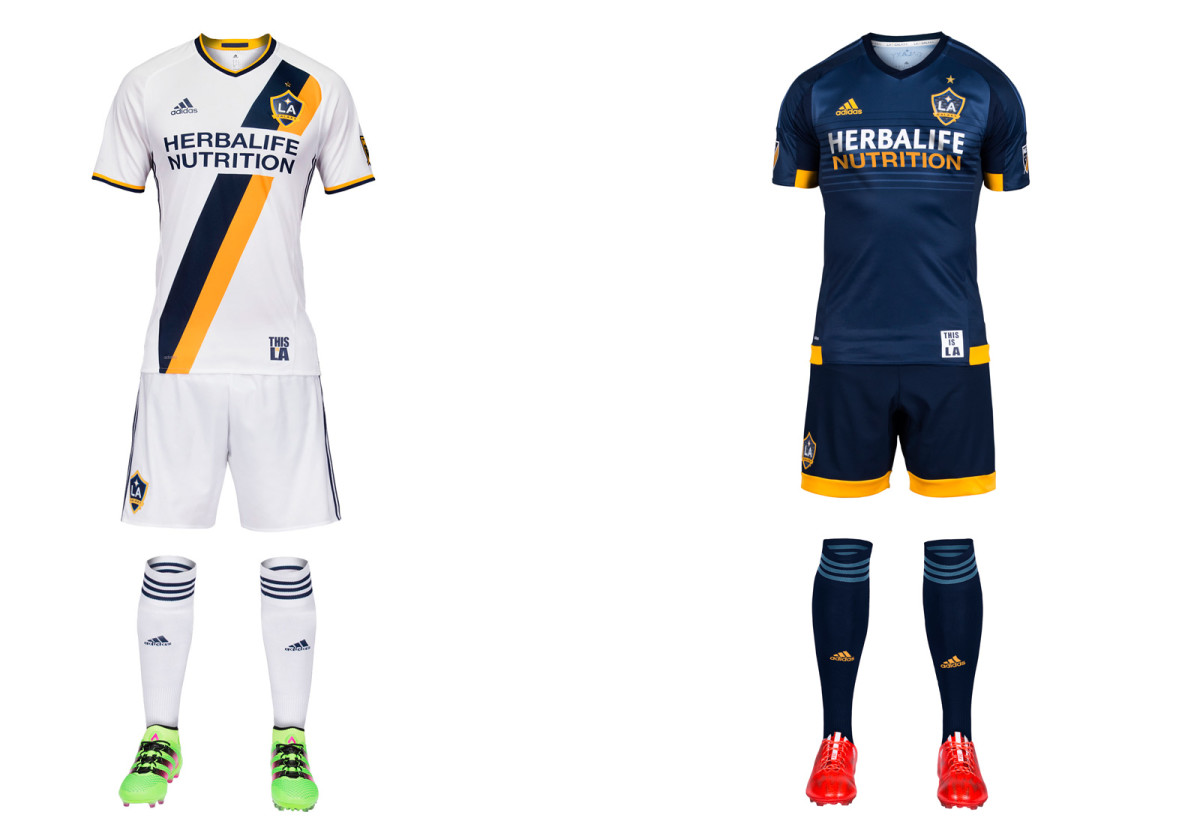
Credit to LA for sticking with the sash introduced in 2012. A club that started black-and-teal and progressed to yellow-and-green finally has an established look to call its own, and it’s a nice one. The new home uniform splits the sash into the modern team colors of blue and yellow, with corresponding flashes on the cuff and collar. It would be perfect save for the enlarged sponsor logo, which cuts too much from the middle of the shirt. The Galaxy carry over their classy blue away kit and thanks to the league's complex new championship star system they'll now wear one gold star above the crest, symbolizing five MLS titles.
Montreal Impact

Finally! We never could understand why the Impact (launched in 1993) didn’t opt for their old school blue and black stripes when moving to MLS in 2012. There was history with the plain blue primary as well, but in the end it was just another anonymous monochromatic uniform in a league full of them. The stripes returned as a popular third option in 2013 and now have been elevated to their proper place as Montreal’s home kit. Black shorts, blue socks and silver highlights round out one of MLS’s most distinctive looks. Maybe the Impact can wear those shorts and socks on the road as well.
New England Revolution

No team embraced the post-1996 regression to the bland like the Revs, who wore the most nondescript uniforms in MLS for years. That changed in 2014 with the addition of white shorts to the navy blue home kit. A total departure from the old all-white aways—a red homage to the old regional flag—followed last year. This season’s primary represents another step forward. The white shorts remain, thankfully, while a beautiful new jersey features red and white stripes down the center. The club said the look is inspired by American Revolution-era jackets. The secondary kit carries over. The inspiration there is commendable but the boxy execution is lacking.
New York City FC

MLS didn’t need another all-black uniform, and NYCFC did the right thing by ditching last year’s away set in favor of something more aligned with the club’s colors and branding. What they came up with, however, will take some getting used to. The dizzying new secondary kit is anchored by a blue jersey with a “ripple pattern inspired by the energy of the five boroughs.” It’s unique, for sure, and while some won’t like it, secondaries don’t necessarily need to be timeless. Adidas also supplied orange shorts as an option, in case the mono-blue isn’t loud enough. NYCFC’s classy home uniform, which looks good even though Manchester City wore it first, carries over from its inaugural season.
New York Red Bulls

New York is red, except when it’s navy blue and yellow. Despite some supporters’ preference for a red away uniform, the Red Bulls are sticking with the colors they share with the parent company’s teams in Leipzig and Salzburg. The new secondary, which now features yellow sleeves, certainly is eye-catching even if it doesn’t stir fans’ souls. NYRB’s brand transcends the crest and kit, anyway. The stadium, history and the personalities who’ve donned MetroStar red-and-black and Red Bull red-and-white are what give this club its identity. NYRB sort of acknowledges that with the red-and-black necktape and MetroStars shield inside the new away jersey. The red-sleeved home kit is identical to last year’s.
Orlando City SC

Purple is the defining feature of Orlando City’s brand, but the club blew it during its expansion season by rolling out a plain white away kit that looked too much like all the others. Now there’s progress in the form of purple sleeves, which add a welcome bit of color and make the new secondary uniform one that only Orlando could wear. The crest features a "3D" lion. The monochromatic home set stays the same. Swap the socks–white at home and purple on the road–and City would be close to perfect.
Philadelphia Union
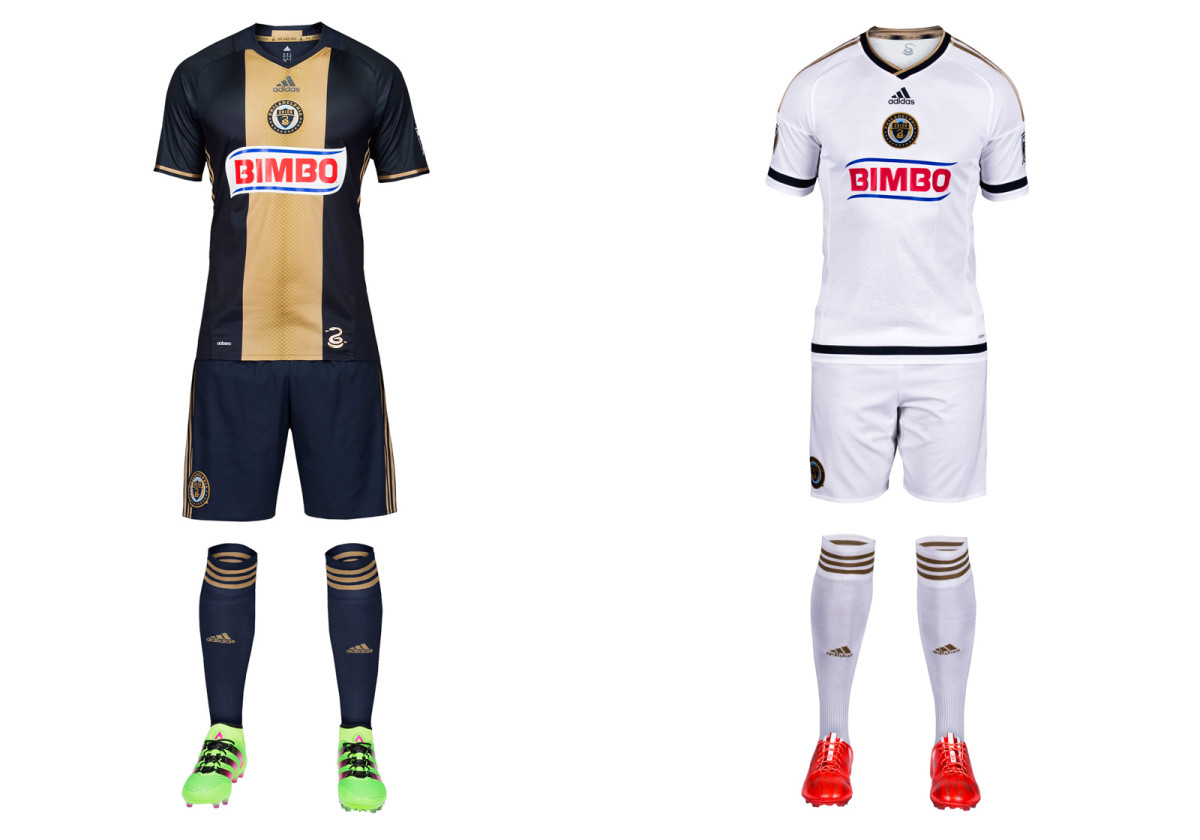
The Union’s home uniform is a modern classic, apart from a garish sponsor logo that looks pasted on instead of integrated with the rest of the jersey. This year’s new primary kit features a lighter gold down the middle, an understated snakeskin pattern (taken from the serpent in the club logo) and the departure of the pinstripes used in 2014-15. It’s as classy and distinctive a set as you’ll find. If only Bimbo could cooperate. Meanwhile, we’re stuck with the regrettable, lazy away kit for one more season.
Portland Timbers

Portland’s "Rose City Red" away uniforms continue to darken, but the overall theme is maintained with the champions’ striking new secondary set. The mostly-black jersey (there's more red on the back) features hoops in shades of red complete with a subtle thorn motif. Red socks add a bit of contrast that would be lost if they were black. The green-and-white home kit is the same as last year’s except for a revised sponsor logo. For Timbers fans, of course, the best part is the new gold star above the crest.
Real Salt Lake
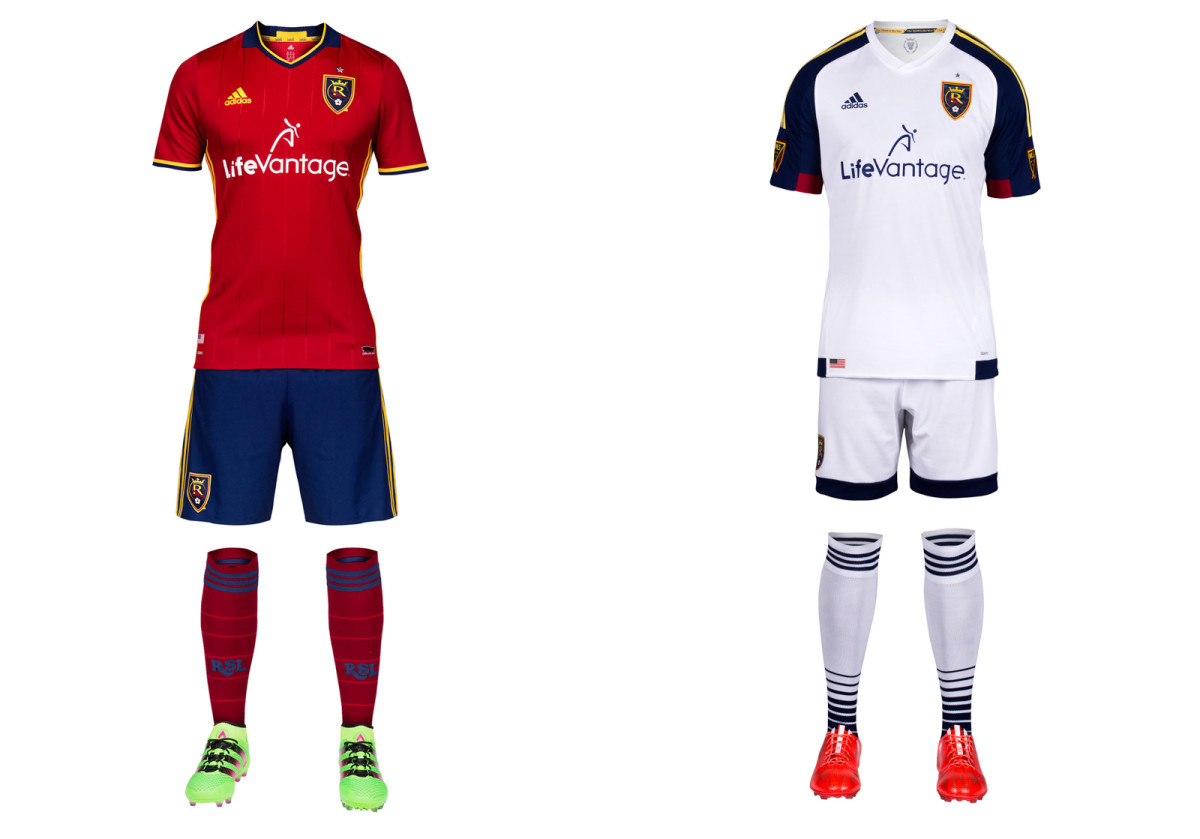
After six years in all-red, RSL at long last is returning to something resembling its unique, championship-winning look. After claiming the 2009 MLS title in red/claret jerseys (with blue/cobalt sleeves), blue shorts and blue socks, RSL inexplicably opted to become one of several mono-red teams. Bad uniforms and a trio of lost finals followed. If there was a kit curse, consider it reversed with the new home set, which features sublimated pinstripes on a sharp red jersey and a return to the cobalt shorts. RSL is RSL again. Let’s hope some variation of “victory gold” replaces the all-white secondary kit in 2017.
San Jose Earthquakes
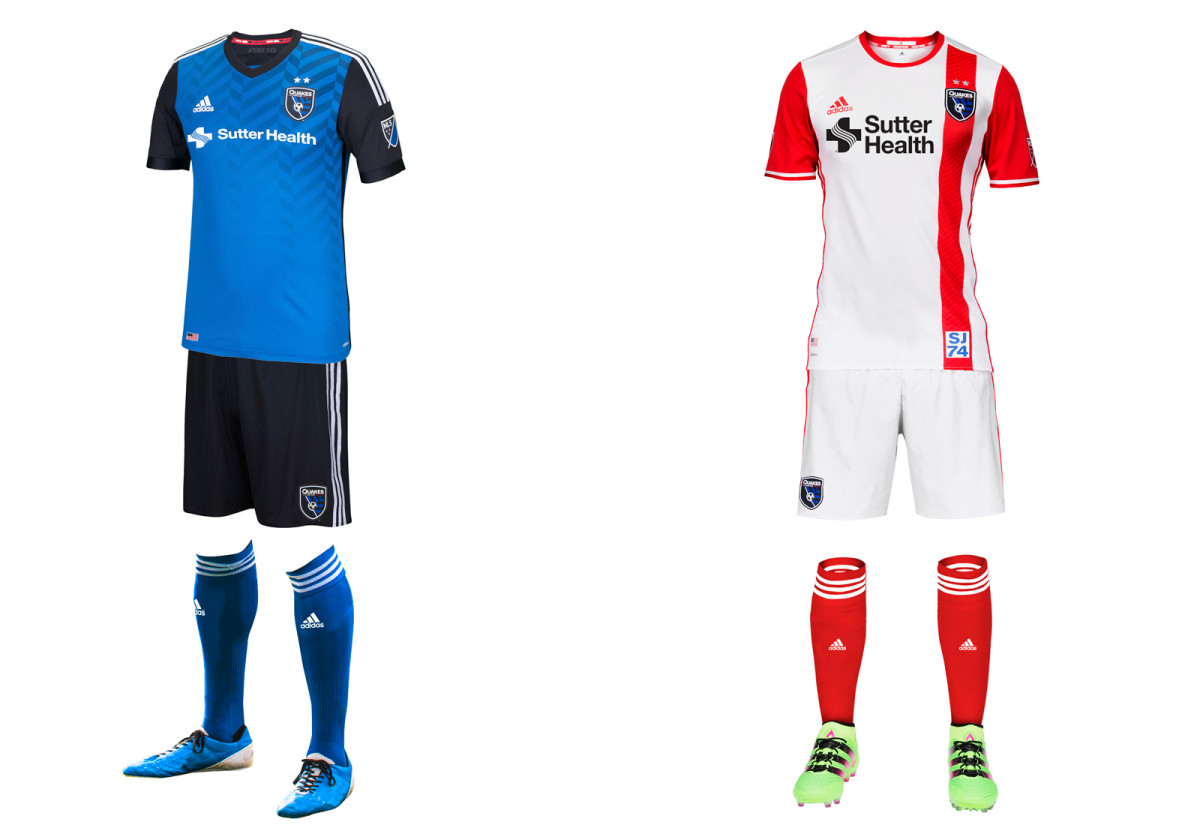
San Jose’s 2014 brand refresh now feels finished with the introduction of a much-improved away set that actually features some red, which connects the modern-day Quakes to their 1970s and ‘80s predecessors. The red stripe, sleeves and socks create a unique, balanced look that ties the club’s crest, primary and secondary kits together. There's also a tiny scorpion inside the neck paying tribute to the branding fiasco that was the San Jose Clash. The sharp blue-and-black home uniform carries over from last season with the addition of the Sutter Health logo. The Earthquakes were the last holdout—for the first time, every MLS team has a jersey sponsor.
Seattle Sounders FC

The only club to introduce two uniforms this year, the Sounders will sport a slightly adjusted version of their iconic rave green primary and a new third kit designed to reflect the colors of Puget Sound. The home set now features blue sleeves and an ’SS’ pattern on the body of the jersey. Seattle may continue the odd tradition of swapping the shorts and socks when wearing the primary on the road. It returns to cyan (and shades of darker blue) on the new third kit, which has a nice Cascadia feel. Hopefully, its arrival means the Sounders will wear the silly all-white secondary as infrequently as possible.
Sporting Kansas City
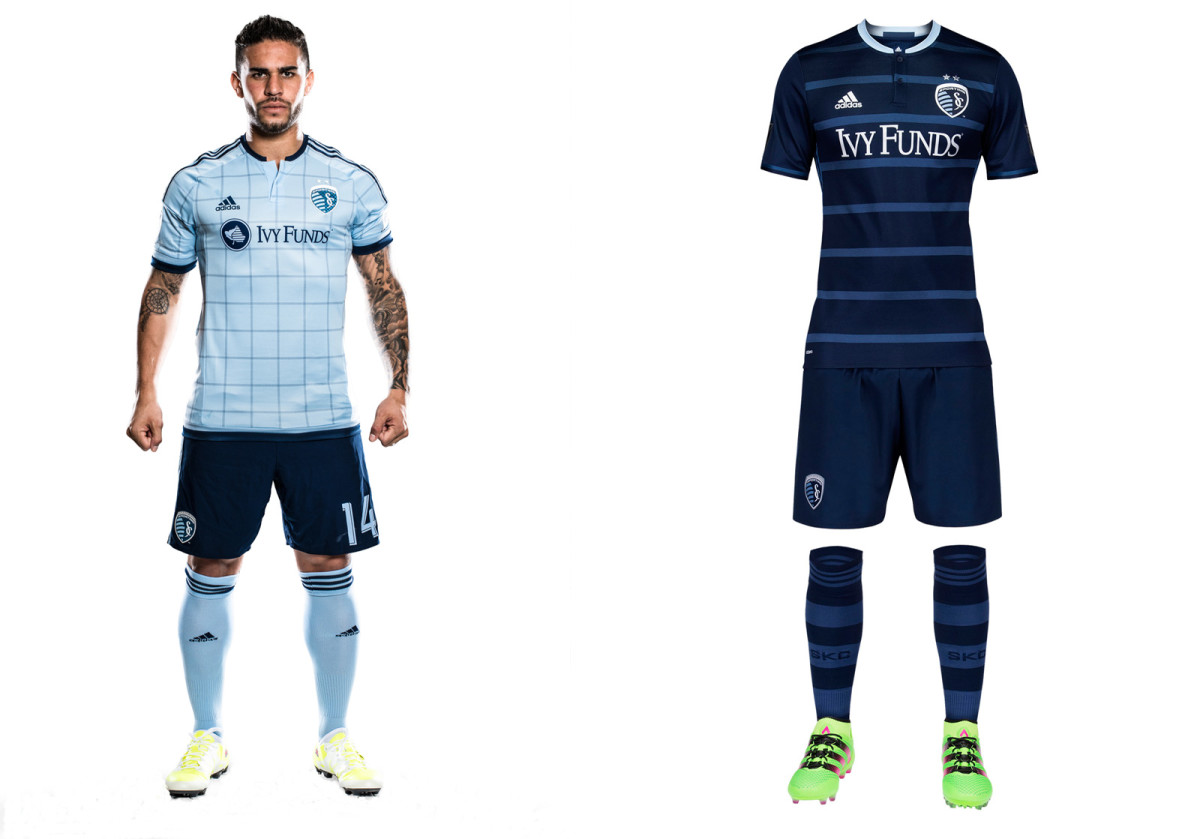
Uniforms typically run on two-year cycles, meaning Sporting had no choice but to move on from its spectacular hooped 2014-15 away set. The replacement is nice enough and the jersey looks good on its own, but the full kit is a bit bland in comparison. The thin hoops are "tonal" rather than "Sporting" blue. The metallic silver numbers and sponsor logo add a bit of glitz. The checkered home uniform debuted last year and still looks good with the dark blue shorts. SKC also will continue wearing its all-white third kit on occasion.
Toronto FC

Entering its 10th season, TFC will include blue in its uniform for the first time. The club’s new away uniform is a colorful nod to the city and its soccer past. Toronto’s flag and its NHL, MLB and CFL teams are primarily blue, and the NASL’s Metros-Croatia and Blizzard wore red and blue in the 1970s and ‘80s. The kit stands out without being garish and means something to the club. Well done, TFC. It also can be worn with red shorts. Gone is the classy dark gray, which we wish was more prominent in the all-red primary.
Vancouver Whitecaps

Vancouver’s new away uniform is its most daring design to date, barring the brown third kit introduced in 2012. But where that one was forgettable, the team’s “Sea to Sky” jersey leaves an impression. The blue gradient evokes the horizon, the North Shore Mountains reflecting on the surface of the water and the club’s initials. It’s gorgeous. The all-white primary carries over from 2015. It includes a bit of subtle blue shading at the shoulders but is otherwise pretty anonymous. The Whitecaps just proved they can do better.
LAFC, Miami and beyond
Los Angeles FC is still targeting 2018 to join MLS in its new stadium, while the timeline for David Beckham’s Miami entry remains more fluid. The league prefers to avoid adding just one expansion team in a given year for scheduling, alignment and logistical reasons, but it’s already demonstrated a willingness to be flexible on Beckham’s behalf. That flexibility now may include voting to allow the retired midfielder to sell the majority of his discounted ownership stake to a third party. Beckham paid $25 million to get in under the terms of his 2007 contract with the LA Galaxy. Minnesota is paying $100 million.
Last week, in a report that a league source described as “very accurate,” The Miami Herald claimed that Beckham was searching for partners and had received “vast interest” from the likes of Chelsea owner Roman Abramovich and Paris Saint-Germain owner Qatar Sports Investments. The same source called QSI the “front-runner” and on Tuesday, SI.com’s Grant Wahl reported that Beckham’s group has been meeting with QSI. The MLS board of governors would have to approve any sale by a 2/3 majority. Considering the league’s interest in Miami, along with the the price of building the Overtown stadium and getting the club up and running, a ‘yes’ vote seems inevitable.
Renderings vs. Reality: Why do stadium designs frequently change?
When Miami enters, MLS will have reached the 24-teams-by-2020 threshold it targeted in 2013. Then it will begin setting a course for 28. Sacramento and St. Louis appear to be the early favorites for teams 25 and 26. The former, which has set USL attendance records, already has an investor group and control of a piece of downtown property suitable for a new stadium. It would take about a year-and-a-half to construct.
MLS is expanding quickly and it feels no pressure to add even more teams before 2020, leaving Sacramento with little choice but to bide its time and prepare. If Republic gets the green light this year, it certainly could have its Railyards facility up and running by 2019, if not earlier.
St. Louis has become far more attractive thanks to the departure of the Rams and the potential access to some of the $400 million in public funding that was proposed for a new NFL stadium. A riverfront MLS arena would be far less expensive, and the league believes that securing ownership wouldn’t be a problem.
“We are very excited about the possibilities in St. Louis. We believe it’s MLS-ready,” commissioner Don Garber told the St. Louis Post-Dispatch this month. “We’ve got a lot of work to do as it relates to determining a stadium solution, and figuring out who ultimately can be the owner of the team. But, overall, we’re very focused on St. Louis as a potential expansion market.”
The expansion bid’s point man is Dave Peacock, the former president of Anheuser-Busch who currently chairs the St. Louis Sports Commission. He’s responsible for pulling an ownership group together and likely would be a minority investor.
One source told SI.com that the league might be waiting for St. Louis (or another market) to “mature” so it can announce two expansion sites simultaneously. Sacramento and St. Louis anchor the country’s 20th and 21st largest media markets, respectively.
San Antonio also is back on the league’s radar following the purchase of a USL franchise by Spurs Sports & Entertainment. There is definite MLS ambition in the Alamo City, but San Antonio FC is just getting started and one source said that the club likely will need three to four years to lay the groundwork for the potential jump.
